Cell - the unit of life MCQ Solved Paper for GATE
Thursday 9th of March 2023

Sharing is caring
1. The cell theory was given in year 1839 by Schleiden and Schwann. According to this theory all organisms are composed of cell and cells are the basic unit of life.
How did this theory help in the field of science?
A. It helped to study the working of cells.
B. It helped in curing diseases caused by cell.
C. It helped in restating the earlier theories on cell.
D. It helped in introducing the use of microscopes to study cell.
Answer : A
How did this theory help in the field of science?
A. It helped to study the working of cells.
B. It helped in curing diseases caused by cell.
C. It helped in restating the earlier theories on cell.
D. It helped in introducing the use of microscopes to study cell.
Answer : A
2. The best material for study of structure of cell membrane is
A. RBC of human
B. RBC of frog
C. cheek cell of human
D. liver cell of rat
Answer : A
A. RBC of human
B. RBC of frog
C. cheek cell of human
D. liver cell of rat
Answer : A
3. _______________ is the important site of formation of glycoproteins and golycolipids.
A. SER
B. Lysosome
C. Golgi apparatus
D. Mitochondria
Answer : C
A. SER
B. Lysosome
C. Golgi apparatus
D. Mitochondria
Answer : C
4. Identify the components labelled as A, B, C, D and E in the diagram given below from the list (i) to (viii).
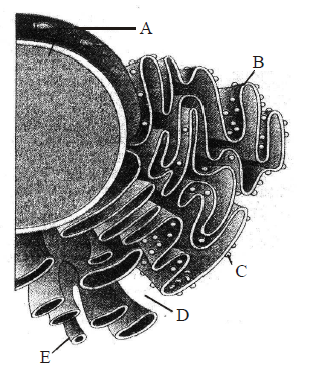
A. A - (viii), B - (v), C - (vii), D - (iii), E - (iv)
B. A - (i), B - (iv), C - (vii), D - (vi), E - (iii)
C. A - (vi), B - (v), C - (iv), D - (vii), E - (i)
D. A - (v), B - (i), C - (iii), D - (ii), E - (iv)
Answer : A

- Cristae of mitochondria
- Inner membrane of mitochondria
- Cytoplasm
- Smooth endoplasmic reticulum
- Rough endoplasmic reticulum
- Mitochondrial matrix
- Ribosome
- Nucleus
A. A - (viii), B - (v), C - (vii), D - (iii), E - (iv)
B. A - (i), B - (iv), C - (vii), D - (vi), E - (iii)
C. A - (vi), B - (v), C - (iv), D - (vii), E - (i)
D. A - (v), B - (i), C - (iii), D - (ii), E - (iv)
Answer : A
5. Match column-I and column-II and select the correct answer
A. A III; B IV; C II; D I
B. A II; B IV; C III; D I
C. A I; B II; C III; D IV
D. A IV; B III; C I ; D II
Answer : B
| Column-I | Column-II |
|---|---|
| A. Bacteria without walls | I. Lysosome |
| B. Small circular DNA | II. Mycoplasma cells |
| C. Flattened sacs in | III. Thylakoid a chloroplast |
| D. A vesicle in which | IV. Plasmid hydrolytic enzymes are stored |
A. A III; B IV; C II; D I
B. A II; B IV; C III; D I
C. A I; B II; C III; D IV
D. A IV; B III; C I ; D II
Answer : B
6. Select the incorrect statement about prokaryotic ribosomes.
A. 50S and 30S subunits unite to form 70S ribosomes.
B. Polysome/polyribosome consists of many ribosomes only.
C. Ribosome is the site of protein synthesis.
D. Polysome indicate the synthesis of identical poolypeptide in multiple copies.
Answer : B
A. 50S and 30S subunits unite to form 70S ribosomes.
B. Polysome/polyribosome consists of many ribosomes only.
C. Ribosome is the site of protein synthesis.
D. Polysome indicate the synthesis of identical poolypeptide in multiple copies.
Answer : B
7. The cytoskeleton is a proteinaceous network of fibres in the cytoplasm. It is involved in
A. mechanical support.
B. motility.
C. maintenace of cell-shape.
D. all of the above
Answer : D
A. mechanical support.
B. motility.
C. maintenace of cell-shape.
D. all of the above
Answer : D
8. Which of the following statements is/are correct ?
A. (ii), (iii) & (iv)
B. (i) only
C. (ii) only
D. (iii) only
Answer : A
- The endomembrane system includes plasma membrane, ER, Golgi complex, lysosomes and vacuoles.
- ER helps in the transport of substances, synthesis of proteins, lipoproteins and glycogen.
- Ribosomes are involved in protein synthesis.
- Mitochondria help in oxidative phosphorylation and generation of ATP.
A. (ii), (iii) & (iv)
B. (i) only
C. (ii) only
D. (iii) only
Answer : A
9. Read the folowing statements and identify the correct option.
A. (i) and (ii)
B. (ii) and (iv)
C. (i), (ii) and (iv)
D. None of the above
Answer : C
- Contractile vacuole takes part in osmoregulation and excretion.
- Food vacuole is formed by engulfing the food particles.
- The vacuole is bound by a double membrane called tonoplast.
- Vacuole can occupy upto 90 percent of the volume of the cell.
A. (i) and (ii)
B. (ii) and (iv)
C. (i), (ii) and (iv)
D. None of the above
Answer : C
10. Which one of the following structures between two adjacent cells is an effective transport pathway?
A. Plasmodesmata
B. Plastoquinones
C. Endoplasmic reticulum
D. Plasmalemma
Answer : A
A. Plasmodesmata
B. Plastoquinones
C. Endoplasmic reticulum
D. Plasmalemma
Answer : A
11. In prokaryotes, chromatophores are
A. specialized granules responsible for colouration of cells
B. structures responsible for organizing the shape of the organism.
C. inclusion bodies lying free inside the cells for carrying out various metabolic activities.
D. internal membrane system which becomes extensive and complex in photosynthetic bacteria.
Answer : D
A. specialized granules responsible for colouration of cells
B. structures responsible for organizing the shape of the organism.
C. inclusion bodies lying free inside the cells for carrying out various metabolic activities.
D. internal membrane system which becomes extensive and complex in photosynthetic bacteria.
Answer : D
12. Chromosomes having equal or almost equal arms are called
A. metacentric
B. acrocentric
C. polycentric
D. acentric.
Answer : A
A. metacentric
B. acrocentric
C. polycentric
D. acentric.
Answer : A
13. Integral proteins of cell membrane occur on/in
A. inner surfaces
B. outer surfaces
C. phospholipid matrix
D. inner and outer surfaces
Answer : D
A. inner surfaces
B. outer surfaces
C. phospholipid matrix
D. inner and outer surfaces
Answer : D
14. Protein synthesis in an animal cell occurs
A. on ribosomes present in cytoplasm as well as in mitochondria.
B. on ribosomes present in the nucleolus as well as in cytoplasm.
C. only on ribosomes attached to the nuclears envelope and endoplasmic reticulum.
D. only on the ribosomes present in cytosol.
Answer : A
A. on ribosomes present in cytoplasm as well as in mitochondria.
B. on ribosomes present in the nucleolus as well as in cytoplasm.
C. only on ribosomes attached to the nuclears envelope and endoplasmic reticulum.
D. only on the ribosomes present in cytosol.
Answer : A
15. Most of water, in mature plant cells occurs in
A. nucleus
B. cell wall
C. vacuoles
D. cytoplasm
Answer : C
A. nucleus
B. cell wall
C. vacuoles
D. cytoplasm
Answer : C
16. Which one of the following is not considered as part of the endomembrane system?
A. Golgi complex
B. Peroxisome
C. Vacuole
D. Lysosome
Answer : B
A. Golgi complex
B. Peroxisome
C. Vacuole
D. Lysosome
Answer : B
17. In the given figure of animal cell, one orginelle is marked as A. Select the correct identification and function of the organelle A from th given option.
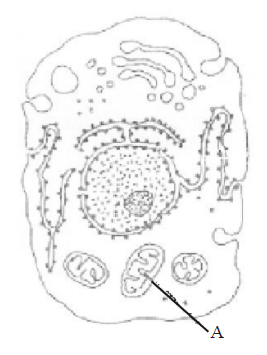
A. Endoplasmic reticulum Synthesis of lipids.
B. Mitochondria Produce cellular energy in the form of ATP.
C. Golgi body Provides packaging material.
D. Lysosomes Secrete hydrolytic enzymes.
Answer : B

A. Endoplasmic reticulum Synthesis of lipids.
B. Mitochondria Produce cellular energy in the form of ATP.
C. Golgi body Provides packaging material.
D. Lysosomes Secrete hydrolytic enzymes.
Answer : B
18. Match column-I with column-II and select the correct option.
A. A III, B II, C IV, D I
B. A II, B III, C IV, D I
C. A I, B III, C II, D IV
D. A IV, B II, C III, D I
Answer : A
| Column - I | Column - II |
|---|---|
| A. RER | I. Intracellular and extracellular digestion |
| B. Cell wall | II. Provide structural support to the cell |
| C. Flagella | III. Protein synthesis and secretion |
| D. Lysosomes | IV Responsible for cell movement |
A. A III, B II, C IV, D I
B. A II, B III, C IV, D I
C. A I, B III, C II, D IV
D. A IV, B II, C III, D I
Answer : A
19. Identify the components labelled A, B, C and D in the given section of cilia/flagella showing different parts. Choose the option which shows the correct labelling of parts.
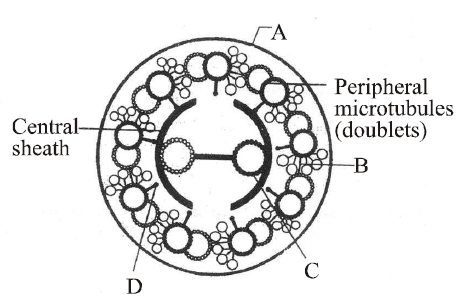
A. A Plasma membrane, B Interdoublet bridge, C Central microtubule, D Radial spoke
B. A Plasma membrane, B Arm, C Central microtubule, D Radial spoke
C. A Plasma membrane, B Interdoublet bridge, C Hub, D Radial spoke
D. A Plasma membrane, B Interdoublet bridge, C Hub, D Arm
Answer : A

A. A Plasma membrane, B Interdoublet bridge, C Central microtubule, D Radial spoke
B. A Plasma membrane, B Arm, C Central microtubule, D Radial spoke
C. A Plasma membrane, B Interdoublet bridge, C Hub, D Radial spoke
D. A Plasma membrane, B Interdoublet bridge, C Hub, D Arm
Answer : A
20. Which of the following statements are incorrect ?
A. (i) and (iii)
B. (iii) and (iv)
C. (ii) and (iv)
D. (i) and (iv)
Answer : A
- Plant cells have centrioles which are absent in almost all animal cells.
- Ribosomes are the site of protein synthesis.
- The middle lamella is a layer mainly of calcium carbonate which holds the different neighbouring cells together.
- In animal cell, steroidal hormones are synthesized by smooth endoplasmic reticulum. Of the above statements
A. (i) and (iii)
B. (iii) and (iv)
C. (ii) and (iv)
D. (i) and (iv)
Answer : A
21. Active transport differs from passive transport in that active transport
A. requires energy.
B. always requires input of ATP.
C. moves molecules against a concentration gradient.
D. both (a) and (c)
Answer : D
A. requires energy.
B. always requires input of ATP.
C. moves molecules against a concentration gradient.
D. both (a) and (c)
Answer : D
22. Which of the following terms is not correctly matched with its feature?
A. Osmosis Movement of water by diffusion.
B. Nucleoplasm Site of active synthesis of ribosomal RNA.
C. Mesosome Infolding of cell membrane and characteristics of eukaryotes.
D. Pili Elongated tubular surface structures (made of special protein) of bacteria.
Answer : C
A. Osmosis Movement of water by diffusion.
B. Nucleoplasm Site of active synthesis of ribosomal RNA.
C. Mesosome Infolding of cell membrane and characteristics of eukaryotes.
D. Pili Elongated tubular surface structures (made of special protein) of bacteria.
Answer : C
23. Nucleolus is
A. rounded structure found in cytoplasm near nucleus.
B. rounded structure inside nucleus and having rRNA.
C. rod-shaped structure in cytoplasm near the nucleus.
D. none of the above.
Answer : B
A. rounded structure found in cytoplasm near nucleus.
B. rounded structure inside nucleus and having rRNA.
C. rod-shaped structure in cytoplasm near the nucleus.
D. none of the above.
Answer : B
24. Which of the following statements is/are correct ?
A. (i), (ii), (iii) and (iv)
B. Only (i) and (ii)
C. Only (iv)
D. None of the above
Answer : A
- The shape of the cells may vary with the function they perform.
- Human RBC is about 7.0 ??m in diameter.
- Cytoplasm is the main area of cellular activities.
- Various chemical reactions occur in cytoplasm to keep the cell in the living state.
A. (i), (ii), (iii) and (iv)
B. Only (i) and (ii)
C. Only (iv)
D. None of the above
Answer : A
25. The following diagram shows some of the missing structures in a plant cell marked as A, B, C, D E. Choose the option with their correct names.
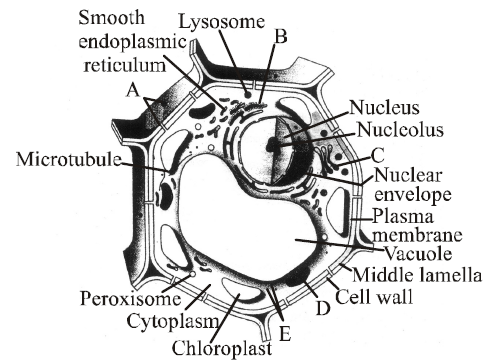
A. A - Plasmodesmata, B - Rough endoplasmic reticulum, C - Golgi apparatus, D - Mitochondrion, E - Ribosomes
B. A - Desmosome, B - Rough endoplasmic reticulum, C - Golgi apparatus, D - Mitochondrion, E - Ribosomes
C. A - Plasmodesmata, B - Smooth endoplasmic reticulum, C - Golgi apparatus, D - Mitochondrion, E - Ribosomes
D. A - Tight junction, B - Rough endoplasmic reticulum, C - Golgi apparatus, D - Mitochondrion, E -Ribosomes
Answer : A

A. A - Plasmodesmata, B - Rough endoplasmic reticulum, C - Golgi apparatus, D - Mitochondrion, E - Ribosomes
B. A - Desmosome, B - Rough endoplasmic reticulum, C - Golgi apparatus, D - Mitochondrion, E - Ribosomes
C. A - Plasmodesmata, B - Smooth endoplasmic reticulum, C - Golgi apparatus, D - Mitochondrion, E - Ribosomes
D. A - Tight junction, B - Rough endoplasmic reticulum, C - Golgi apparatus, D - Mitochondrion, E -Ribosomes
Answer : A
26. Plastids are found in
A. all animal cells.
B. some animal cells.
C. all plant cells.
D. all plant cells and euglenoides.
Answer : D
A. all animal cells.
B. some animal cells.
C. all plant cells.
D. all plant cells and euglenoides.
Answer : D
27. Centrifugation of a cell results in the rupture of the cell membrane and the contents compacting into a pellets in the bottom of the centrifuge tube. Bathing this pellet with a glucose solution yields metabolic activity including the production of ATP. One of the contents of this pellet is most likely which of the following?
A. Cytosol
B. Mitochondria
C. Lysosomes
D. Golgi bodies
Answer : B
A. Cytosol
B. Mitochondria
C. Lysosomes
D. Golgi bodies
Answer : B
28. The lipid component of the membrane mainly consists of __________.
A. polysaccharides
B. phosphoglyceride
C. monosaccharaides
D. both (a) and (c)
Answer : B
A. polysaccharides
B. phosphoglyceride
C. monosaccharaides
D. both (a) and (c)
Answer : B
29. According to widely accepted fluid mosaic model cell membranes are semi-fluid, where lipids and integral proteins can diffuse randomly. In recent years, this model has been modified in several respects. In this regard, which of the following statements is incorrect?
A. Proteins in cell membranes can travel within the lipid bilayer.
B. Proteins can also undergo flip-flop movements in the lipid bilayer.
C. Proteins can remain confined within certain domains of the membrane.
D. Many proteins remain completely embedded within the lipid bilayer.
Answer : B
A. Proteins in cell membranes can travel within the lipid bilayer.
B. Proteins can also undergo flip-flop movements in the lipid bilayer.
C. Proteins can remain confined within certain domains of the membrane.
D. Many proteins remain completely embedded within the lipid bilayer.
Answer : B
30. Given below are some characters of a cell organelle identify the correct organelle which shows all the characters described above.
A. Golgi apparatus
B. Lysosomes
C. Endoplasmic reticulum br>D. Vacuoles
Answer : D
- It is a membrane bound space found in the cytoplasm.
- It is bound by a single membrane called tonoplast.
- It contains water, sap, excretory products and other materials not useful to the cell.
- It has higher concentration of sap than the cytoplasm.
A. Golgi apparatus
B. Lysosomes
C. Endoplasmic reticulum br>D. Vacuoles
Answer : D
31. Consider the following statements and choose the correct statement.
A. (i) and (iii)
B. (ii) and (iv)
C. (iii) and (iv)
D. (ii) and (iii)
Answer : D
- The endomembrane system includes mitochondria, chloroplast and peroxisomes.
- Smooth endoplasmic reticulum is the major site for synthesis of lipid.
- Rough endoplasmic reticulum is actively involved in protein synthesis.
- Mitochondrial matrix possesses single circular DNA, a few RNA and 80S ribosomes. Of the above statements.
A. (i) and (iii)
B. (ii) and (iv)
C. (iii) and (iv)
D. (ii) and (iii)
Answer : D
32. Which of the following option correctly match A, B, C, and D indicated in the given sectional view of chloroplasts.

A. A - Thylakoid, B-Stromal lamella, C - Stroma, D - Granum
B. A - Granum, B - Thylakoid, C - Stromal lamella, D - Stroma
C. A - Thylakoid, B - Granum, C - Stromal lamella, D - Stroma
D. A - Granum, B - Thylakoid, C - Stroma, D - Stromal lamella
Answer : B

A. A - Thylakoid, B-Stromal lamella, C - Stroma, D - Granum
B. A - Granum, B - Thylakoid, C - Stromal lamella, D - Stroma
C. A - Thylakoid, B - Granum, C - Stromal lamella, D - Stroma
D. A - Granum, B - Thylakoid, C - Stroma, D - Stromal lamella
Answer : B
33. Match column-I with column-II and select the correct option.
A. A - IV, B - V, C - I, D - II
B. A - I, B - II, C - IV, D - III
C. A - IV, B - I, C - II, D - III
D. A - I, B - II, C - III, D - IV
Answer : A
| Column - I | Column - II |
|---|---|
| A. Golgi apparatus | I. Storage |
| B. Mitochondria | II. Photosynthesis |
| C. Vacuoles | III. Transport |
| D. Grana | IV. Secretion |
| .. | V. Respiration |
A. A - IV, B - V, C - I, D - II
B. A - I, B - II, C - IV, D - III
C. A - IV, B - I, C - II, D - III
D. A - I, B - II, C - III, D - IV
Answer : A
34. Lysosomes contain
A. carbohydrates
B. hormones
C. nucleic acids
D. hydrolases.
Answer : D
A. carbohydrates
B. hormones
C. nucleic acids
D. hydrolases.
Answer : D
35. Which of the following organelles is directly connected to the outer membrane of the nucleus in a eukaryotic cell?
A. Mitochondrion
B. Lysosome
C. Golgi apparatus
D. Endoplasmic reticulum
Answer : D
A. Mitochondrion
B. Lysosome
C. Golgi apparatus
D. Endoplasmic reticulum
Answer : D
36. The given diagram shows the types of chromosomes (labelled as A, B, C & D) based on the position of centromere.
Which one is the correct option for the labelled chromosomes. A, B, C and D ?

A. A Telocentric chromosome, B Acrocentric chromosome, C Submetacentric chromosome, D Metacentric chromosome
B. A Acrocentric chromosome, B Telocentric chromosome, C Metacentric chromosome, D Submetacentric chromosome
C. A Submetacentric chromosome, B Metacentric chromosome, C Telocentric chromosome, D Acrocentric chromosome
D. A Metacentric chromosome, B Submetacentric chromosome, C Acrocentric chromosome, D Telocentric chromosome.
Answer : A
Which one is the correct option for the labelled chromosomes. A, B, C and D ?

A. A Telocentric chromosome, B Acrocentric chromosome, C Submetacentric chromosome, D Metacentric chromosome
B. A Acrocentric chromosome, B Telocentric chromosome, C Metacentric chromosome, D Submetacentric chromosome
C. A Submetacentric chromosome, B Metacentric chromosome, C Telocentric chromosome, D Acrocentric chromosome
D. A Metacentric chromosome, B Submetacentric chromosome, C Acrocentric chromosome, D Telocentric chromosome.
Answer : A
37. The following diagram represents a structure chromosome.
Identify the structures marked as A, B and C.
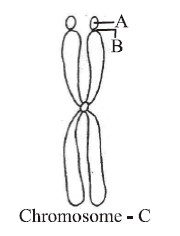
A. A - Satellite, B - Primary constriction, C - Acrocentric
B. A - Satellite, B - Secondary constriction, C - Metacentric
C. A - Satellite, B - Centromere, C - Telocentric
D. A - Satellite, B - Centromere, C - Submetacentric
Answer : B
Identify the structures marked as A, B and C.

A. A - Satellite, B - Primary constriction, C - Acrocentric
B. A - Satellite, B - Secondary constriction, C - Metacentric
C. A - Satellite, B - Centromere, C - Telocentric
D. A - Satellite, B - Centromere, C - Submetacentric
Answer : B
38. Which of the following lacks cell wall?
A. Gametes
B. Amoeba
C. Mycoplasma
D. All of these
Answer : D
A. Gametes
B. Amoeba
C. Mycoplasma
D. All of these
Answer : D
39. A component of cytoskeleton is
A. microtubule
B. bone
C. chitin
D. cartilage.
Answer : A
A. microtubule
B. bone
C. chitin
D. cartilage.
Answer : A
40. Which of the following is incorrect ?
A. Mycoplasma is the smallest cell (0.3 �).
B. Bacteria are 3 to 5 �m in size.
C. The largest cell is the egg of an ostrich.
D. Nerve cells are some of the smallest cells.
Answer : D
A. Mycoplasma is the smallest cell (0.3 �).
B. Bacteria are 3 to 5 �m in size.
C. The largest cell is the egg of an ostrich.
D. Nerve cells are some of the smallest cells.
Answer : D
41. Cell sap is a
A. living content of cytoplasm.
B. nonliving content of cytoplasm.
C. nonliving content of vacuole.
D. living content of vacuole.
Answer : C
A. living content of cytoplasm.
B. nonliving content of cytoplasm.
C. nonliving content of vacuole.
D. living content of vacuole.
Answer : C
42. Which one of the following organelle given below is correctly matched with its function ?
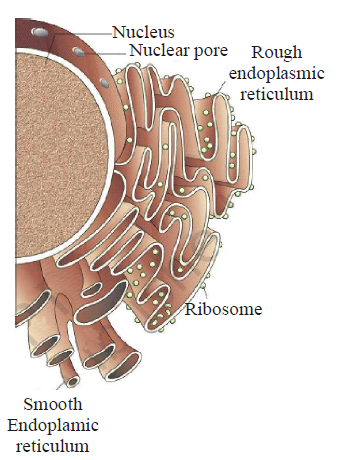
A. Golgi apparatus Protein synthesis
B. Golgi apparatus Formation of glycolipids
C. Rough endoplasmic reticulum Protein synthesis
D. Rough endoplasmic reticulum Formation of glycoproteins
Answer : C

A. Golgi apparatus Protein synthesis
B. Golgi apparatus Formation of glycolipids
C. Rough endoplasmic reticulum Protein synthesis
D. Rough endoplasmic reticulum Formation of glycoproteins
Answer : C
43. Which one of the following combination is mismatched?
A. Glycocalyx May be capsule or slime layer
B. Pili Reproduction
C. Cell wall Protective, determines shape, prevents from bursting
D. Flagella, pili and fimbriae Surface structures of bacterial cell
Answer : B
A. Glycocalyx May be capsule or slime layer
B. Pili Reproduction
C. Cell wall Protective, determines shape, prevents from bursting
D. Flagella, pili and fimbriae Surface structures of bacterial cell
Answer : B
44. Which of the following cell organelles were discovered after the introduction of electron microscope?
A. Mitochondria
B. Endoplasmic reticulum
C. Ribosomes
D. Both (b) and (c)
Answer : D
A. Mitochondria
B. Endoplasmic reticulum
C. Ribosomes
D. Both (b) and (c)
Answer : D
45. Match column I (cell type) with column II (size) and choose the correct option.
A. A I, B II, C III, D IV
B. A IV, B III, C II, D I
C. A I, B III, C II, D IV
D. A IV, B II, C III, D I
Answer : B
| Column-I | Column-II |
|---|---|
| (Cell type) | (Size) |
| A. Viruses | I. 1-2 ??m |
| B. PPLO | II. 10-20 ??m |
| C. Eukaryotic cell | III. About 0.1 ??m |
| D. Bacterium | IV. 0.02 - 0.2 ??m |
A. A I, B II, C III, D IV
B. A IV, B III, C II, D I
C. A I, B III, C II, D IV
D. A IV, B II, C III, D I
Answer : B
46. In which method of transport, plasma membrane does not require carrier molecule?
A. Active transport
B. Facilitateddiffusion
C. Simple diffusion
D. Na+ K+ pump
Answer : C
A. Active transport
B. Facilitateddiffusion
C. Simple diffusion
D. Na+ K+ pump
Answer : C
47. Match column-I with column-II and choose the correct option.
A. A IV; B III; C I; D II
B. A II; B III; C IV; D I
C. A IV; B II; C III; D I
D. A I; B III; C II; D IV
Answer : A
| Column-I | Column-II |
|---|---|
| A. Tonoplast | I. Contain digestive enzyme |
| B. Contractile vacuole | II. Store metabolic gases |
| C. Food vacuole | III. Excretion |
| D. Air vacuole | IV. Transport of ions in plants |
A. A IV; B III; C I; D II
B. A II; B III; C IV; D I
C. A IV; B II; C III; D I
D. A I; B III; C II; D IV
Answer : A
48. Polysome is a chain of
A. oxysomes
B. sphaerosomes
C. ribosomes
D. dictyosomes
Answer : C
A. oxysomes
B. sphaerosomes
C. ribosomes
D. dictyosomes
Answer : C
49. 8.A student was given cell samples (A and B) to identify parts which are highlighted. He observed the samples under the microscope and list down the function of the part of cell sample. The information collected by the student is listed in the table below, on the basis of which the student infers that the samples contain the organelles.
Identify the part highlighted in the sample A and B and explain why they were called as semi-autonomous organelles?
A. Sample A - Mitochondria, Sample B - Chloroplast; because both the organelles are double membrane bound structure.
B. Sample A- Mitochondria, Sample B - Chloroplast; because they both are capable of synthesis of their own proteins only.
C. Sample A - Mitochondria, Sample B - Chloroplast; because they are capable of synthesis of their own proteins and contain their own DNA.
D. Sample A- Mitochondria, Sample B - Chloroplast; because they contain their own DNA to transfer the genetic information from one generation to another.
Answer : C
| Sample A | Sample B |
|---|---|
| Make energy available for cellular metabolism | Generates ATP and synthes izes s ugar |
| Absent in cell that carry oxygen throughout the body | Present in plant cell |
| Called the energy currency of cell | Source o f all the food energy |
Identify the part highlighted in the sample A and B and explain why they were called as semi-autonomous organelles?
A. Sample A - Mitochondria, Sample B - Chloroplast; because both the organelles are double membrane bound structure.
B. Sample A- Mitochondria, Sample B - Chloroplast; because they both are capable of synthesis of their own proteins only.
C. Sample A - Mitochondria, Sample B - Chloroplast; because they are capable of synthesis of their own proteins and contain their own DNA.
D. Sample A- Mitochondria, Sample B - Chloroplast; because they contain their own DNA to transfer the genetic information from one generation to another.
Answer : C
50. Which of the following pair are correctly matched.
A. Microtubules Structural components of cilia
B. Centrioles Store hydrolytic enzymes
C. Amyloplasts Store oil protein and starch in plants
A. A, B and C
B. A and B
C. A
D. A and C
Answer : C
A. Microtubules Structural components of cilia
B. Centrioles Store hydrolytic enzymes
C. Amyloplasts Store oil protein and starch in plants
A. A, B and C
B. A and B
C. A
D. A and C
Answer : C